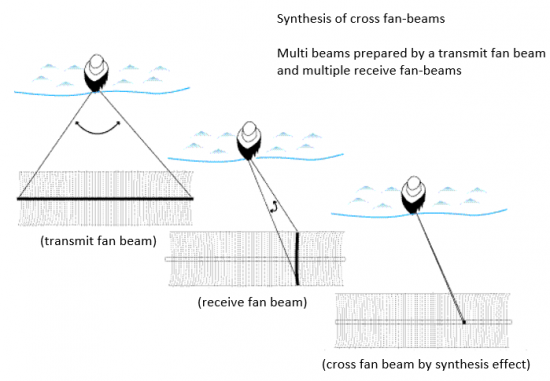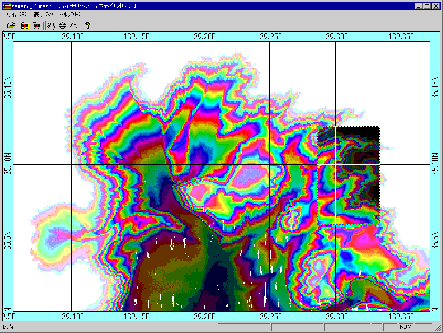| Technology for research on the ocean floor | |
| The measurement of water depth by the multibeam echo sounder | |
|
The Multibeam Echo Sounder is used to measure the depth of the seabed. It calculates the water depth by measurement of the time between the sound waves (acoustic beam) fired from the bottom of the ship and reflected from the seabed. By the ship firing multiple waves to fan into the sea of left and right during sailing, the depth of the seabed with a considerable width can be measured without gap like aerial photogrammetry on land. This multibeam echo sounder has the following advantages.
For this reason, in recent years the multibeam sounder becomes to be used widely, significant progress has been made in terms of technical and practical use.
|
|
| The basic principle of cross-fan-beam system | |
|
Wave transmitters and receivers of the multibeam echo sounder are fixed to ship bottom orthogonally. The transmitters emit fan-shaped beams (fan-beam) toward safer and the orthogonal receivers receive the reflected waves which are also fanning shaped. Because measurement values are obtained from the intersection points, it is called the cross-fan-beam method. |
|
 |
|
|
Water depth can be measured by measuring the travelling time between outgoing sound waves and returning sound waves reflected from the seabed. The value of water depth can be roughly calculated by the equation below. Water depth = (one-way propagation time of a sound wave) × (speed of sound waves traveling through the sea) × cos (angle of inclination of the beam) Currently, various models of multibeam sounders have been developed, using sound waves of frequencies of 12 kHz ~ 500 kHz for from the shallow sea to the deep sea. That is because the sound waves of different frequencies are used for investigation depth and research purposes. For example, to sounding in the continental shelf area, etc., frequencies of 100 ~ 200 kHz are used. By emitting around 150 beams, the exploration width of about 3 times the water depth is obtained with a resolution of 0.5 degrees. To sounding from the shallow sea to the ultra deep sea of 11,000 m, frequencies of around 12 kHz are used. This time, by using about 120 beams, the exploration width of about 3 times the water depth is obtained with a resolution of 2 degrees. |
|
| An Example of Bathymetric map | |
 |
|
|
The figure above is a bathymetric map of the fan-shaped delta that is developed in steep slope of the seabed between Sakawa River estuary at Kanagawa Prefecture and an inner part of Sagami Bay. As in this example, the cross-fan-beam method is able to fathom the seabed in the entire region by repeating transmission and reception of sound waves during ship sailing. |
|
We have developed the software series "MarineDiscovery" which processes and analyzes the sounding data obtained by multibeam echo sounders. The software provides efficient, precise data processing and analysis with the functions of ping file editing and mesh file editing.
In addition, we have also developed the software series "Visual3DX" which creates 3-dimensional stereoscopic images or videos of terrain data.
Up: Image of noise reduction
Down: Flat display of a structure
Up: Three-dimensional display of a structure
Down: Three-dimensional display of the sea floor at Tokai off by Visual 3DX

